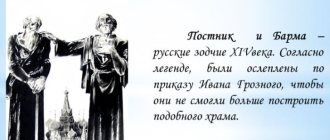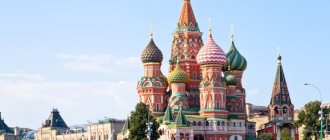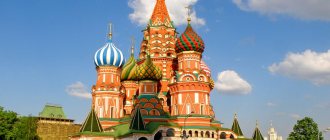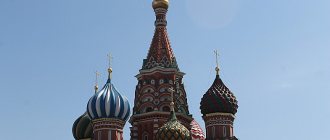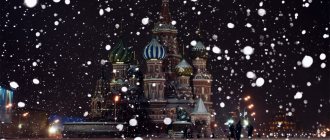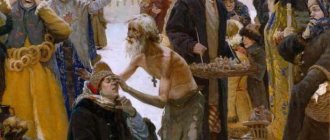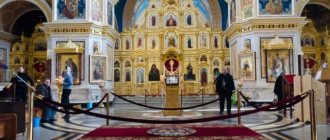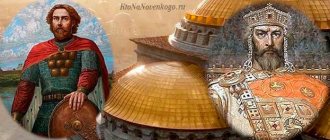- Reports and messages
- Miscellaneous
- St Basil's Church
The most important and beautiful temple in the capital of Russia is St. Basil's Cathedral.
This is not only the main decoration of the city square, it is also an important decoration of Moscow. The emergence of the cathedral is rooted deep in the history of the Russian land. It is known that from the very beginning this territory was occupied by the Church of the Holy Trinity, which was built on a moat. This ditch was specially dug in the 16th century near the eastern walls of the Kremlin. Later, the temple was named in honor of St. Basil, who was a healer and possessed the gift of clairvoyance. There is a well-known story about how once upon a time Tsar Ivan the Terrible invited Vasily to his place for a conversation. It is worth noting that Ivan the Terrible listened to the elder’s advice. The blessed one told him that Novgorod would be plunged into fires. And indeed, news of a fire in the city of Novgorod arrived at the royal chambers. Basil the Blessed also predicted to the tsar that he would proudly capture the capital of the Kazan Khanate. In honor of this event, the king issued a decree on the construction of a cathedral. The new cathedral was named the Intercession of the Virgin Mary on the Moat. Since it was on the day of Intercession that Grozny’s troops captured Kazan. After some time, a small church was erected near the temple, which was named in honor of St. Basil, and he was buried there. For a long time the temple had a discreet appearance. His colors have always been limited to brick and white. Only from the 17th century did the cathedral begin to be decorated with multi-colored images and paints. From this moment on, bell towers and elegant porches were added to the building. Very soon, St. Basil's Cathedral will be complemented by eleven new churches. Sometimes the temple is rebuilt, its color is changed, something is added, and some things are removed. Still, it is being rebuilt slightly. The cathedral has gone through a lot. The French robbed him. Napoleon did not want to leave such beauty to anyone and ordered it to be blown up, but to the surprise of everyone, St. Basil survived and remained unharmed. The October Revolution left its mark on the history of the cathedral. The new Soviet government wanted to demolish it, but this was also unsuccessful. Several more times there were attempts to dismantle and demolish the temple, but it still stands to this day.
Now this is a favorite place not only for visiting guests, the temple is loved and protected by local residents of the city. This is the most picturesque attraction of the square. The cathedral is a system of labyrinths with a large number of stairs. Its beautiful facades are decorated with various patterns and arches. Even today, the ensemble of the cathedral is perfectly complemented by small churches. The abundance of colors and a huge number of multi-colored domes will be the best decoration for any tourist’s photo. This cathedral seems to live a separate life, it is like the soul of the capital.
2, 3, 4, 5, 9 grade description for children message
Popular message topics
- Processor
The processor, or “microprocessor,” is an electronic device called a chip. Its main task is to receive input data, process it according to a certain algorithm and generate the corresponding output data. - Suvorov
The legendary commander Suvorov Alexander Vasilyevich was born in 1730. His father was a nobleman and was in the service of Peter I. Endless stories about the war with the Swedes only strengthened the boy’s dream of building a military career. - Tyrannosaurus
Scientists are still trying to find answers to the following questions: what did this type of dinosaur look like?, why is the tyrannosaurus considered the most famous in history?, what size did it reach?, what is the lifespan of the oldest monster?
Report on the topic St. Basil's Cathedral
The cathedral, which has a second name as Pokrovsky, is located on the territory of Red Square and was built in the middle of the 16th century under the leadership of the architects Postnik Yakovlev and Barma at the behest of Ivan the Terrible, who decided to perpetuate the victory in the battle with the Kazan Khanate in 1552.
The temple owes its name to the storage in it of the relics of the blessed holy fool Vasily, elevated to the rank of saints.
The construction of the temple took more than six years and its current architectural composition consists of nine churches, built of white brick on a single base, united by internal gallery passages, decorated with lush floral ornaments in the form of herbs and flowers, as well as paintings that imitate brickwork. The domes of the temple are created in the form of multi-figured, patterned, onion-shaped and multi-colored domes, while on the central church of the Intercession Cathedral there is a dome in the shape of a tent, which is decorated inside with ornamental black and red paintings made on a white background. The exterior decor of the temple is made using pilasters, panels, arrows, muffed columns, and rosettes.
The interior of the churches that are part of the temple is made in the form of oil iconostases, which are unique priceless historical monuments dating back to the period of the 16th-17th centuries, for example, the Life of Alexander Nevsky, Entrance to Jerusalem, Trinity.
Over the many years of its existence, the temple has accumulated a unique fund, which includes objects of ancient Russian applied art and painting, consisting of metal, wooden, fabric historical items, items related to the sacristy of the cathedral, as well as manuscripts and early printed books.
Since the early thirties of the twentieth century, St. Basil's Cathedral has been one of the components of the historical monuments that are part of the State Historical Museum, in which scientific and restoration research is carried out on an ongoing basis, allowing visitors to present unusually interesting exhibitions.
Since the end of the twentieth century, in the premises of the temple on the days of the Feast of the Intercession and St. Basil's Day, you can attend church services, as well as participate in patriarchal and lordly services.
The majesty and beauty of the Intercession Cathedral classify it as one of the most famous Moscow and all-Russian monuments of architecture and architecture.
2nd, 3rd, 4th grade.
Dimensions:Until the end of the 16th century, the cathedral was the tallest building in Moscow, its height is over 60 m.
Description:
The cathedral consists of eight churches, the thrones of which were consecrated in honor of the holidays that fell on the days of the decisive battles for Kazan: Trinity, in honor of St. Nicholas the Wonderworker (in honor of his Velikoretskaya icon from Vyatka), Entry into Jerusalem, in honor of the martyrs Adrian and Natalia (originally - in honor of Saints Cyprian and Justina - October 2), Saint John the Merciful (until the 18th century - in honor of Saints Paul, Alexander and John of Constantinople - November 6), Alexander of Svir (April 17 and August 30), Varlaam of Khutyn (November 6 and 1st Friday of Peter's Lent), Gregory of Armenia (September 30). All these eight churches (four axial, four smaller ones between them) are crowned with onion domes and grouped around the ninth pillar-shaped church rising above them in honor of the Intercession of the Mother of God, completed with a tent with a small dome. All nine churches are united by a common base, a bypass (originally open) gallery and internal vaulted passages.
Story:
The Intercession Cathedral was built in 1555-60 by order of Ivan the Terrible in memory of the capture of Kazan and the victory over the Kazan Khanate. There are several legends about the creators of the cathedral. According to one of them, the architect was the famous Pskov master Postnik Yakovlev, nicknamed Barma. According to another, widely known version, Barma and Postnik are two different architects, both involved in the construction. According to the third version, the cathedral was built by an unknown Western European master (presumably an Italian, as before - a significant part of the buildings of the Moscow Kremlin), hence such a unique style, combining the traditions of both Russian architecture and European architecture of the Renaissance. According to legend, the architect(s) of the cathedral were blinded by order of Ivan the Terrible so that they could not build another similar temple. However, if the author of the cathedral is Postnik, then he could not have been blinded, since for several years after the construction of the cathedral he participated in the creation of the Kazan Kremlin.
In 1588, a chapel was added to the cathedral from the northeast, consecrated in honor of St. Basil the Blessed (1469-1552), whose relics were located on the site where the cathedral was built. The name of this chapel gave the cathedral a second, everyday name. Adjacent to the chapel of St. Basil's is the chapel of the Nativity of the Blessed Virgin Mary, erected over the burial place of Blessed John of Moscow (initially consecrated in honor of the Placing of the Robe, but in 1680 reconsecrated as the Nativity of the Theotokos), where the relics of St. John the Blessed, found in 1672, rest.
A tented bell tower was built in the 1670s.
The cathedral has been restored several times. In the 17th century, asymmetrical extensions were added, tents over the porches, intricate decorative treatment of the domes (originally they were gold), and ornamental paintings outside and inside (originally the cathedral itself was white).
In the main, Intercession, church there is an iconostasis from the Kremlin Church of the Chernigov Wonderworkers, dismantled in 1770.
More than once the Temple found itself on the brink of destruction and each time remained intact. In 1737, the Intercession Church was badly damaged by fire and was restored. In 1812, the cathedral was looted, but immediately after the war it was repaired. According to legend, Napoleon wanted to transfer the Moscow miracle to Paris, but for now the horses of the French army were stationed in the Temple. The technology of that time turned out to be powerless against this task, and then, before the retreat of the French army, he ordered the Temple to be blown up along with the Kremlin. Muscovites tried to extinguish the lit wicks, and suddenly pouring torrential rain helped stop the explosion.
In 1929, the Temple was closed and the bells were removed. It began to be used for worship again on October 14 (Feast of the Intercession) 1991. Since 1990, the temple-museum again began collecting bells. Currently, this collection is one of the richest active collections not only in Moscow, but also in Russia. In total, the museum has 19 bells, created in 1547-1996 (places of casting: the Urals, Yaroslavl, Moscow, as well as France, Holland, Germany, Western Belarus). The bells were cast by such famous masters as Fedor and Ivan Motorin, Semyon Mozhzhukhin, P.I. Olovyashnikov. P.N. Finnish. A.A. Samghin. The cathedral also has an interesting collection
St. Basil's Cathedral today
St. Basil's Cathedral was included in the UNESCO World Heritage List in 1990. Church services resumed in 1991 and work began to finally bring the cathedral's bells back to life. Today the bell tower houses 19 bells ranging in age from 25 to almost 500 years. In 2007, St. Basil's Cathedral was declared one of the seven wonders of Russia.
Today St. Basil's Cathedral is bustling with spiritual and secular activity. In addition to chapels and church services, it is also home to festivals, exhibitions, art events, concerts and more.
History of origin
The correct name of this building is the Cathedral of the Intercession of the Blessed Virgin Mary. But because of the church included in the Cathedral complex and named after the blessed one, it began to be called St. Basil's Cathedral .
In ancient times, when Tsar Ivan the Terrible ruled Russia, wooden churches were erected on Red Square (then called Trinity) as a sign of victory over enemies. By 1552 there were quite a lot of churches. It so happened that it was on the feast of the Intercession of the Mother of God that Russian soldiers took the Kazan fortress. And then Tsar Ivan the Terrible ordered the wooden churches to be united into one stone temple. The temple was named Intercession Cathedral.
St. Basil's Cathedral - history of creation
Construction of the Cathedral ended in 1561. By 1722, there were 18 churches on the territory of the Cathedral, including St. Basil's Church. But in 1737, the Cathedral and most of the churches were almost completely burned out during a strong fire. The cathedral was quickly restored, after which it was built and rebuilt many times.
You may also be interested in the article: The emergence of statehood among the Eastern Slavs
The Temple received its name in honor of the local holy fool. He walked with chains on his naked body at any time of the year. It was, in a way, a punishment for human sins. The local population considered St. Basil a miracle worker and clairvoyant. After all, he once accurately predicted a fire that destroyed half of Moscow. And even Tsar Ivan the Terrible revered the holy fool and was a little afraid of him.
Basil the Blessed
died in August 1557 at the age of 82. An interesting fact is that the whole city gathered for the funeral, and the king himself and the princes carried the coffin with the body of the blessed one to the church. He was buried near the unfinished temple. 30 years later, a building was erected over his grave. In it he placed an altar with a throne for worship. The extension was given the name of the Blessed One, and later a church was erected here, and the relics of the blessed one were also placed here.
The value of the cathedral and its mark on culture
The value of the majestic structure is not only in the incredible architecture, Gothic style and mythical sculptures. Under the arches of the cathedral, new royal dynasties were formed, knights received blessings, and rich people of Paris kept valuables.
At Notre-Dame de Paris, Napoleon became king of the French Empire. In addition, the cathedral servants helped the poor. Also in the temple the legendary trial of Joan of Arc took place, but after the death of the girl. The court completely acquitted the Frenchwoman.
Cathedrals and churches of the Moscow Kremlin
Cathedrals and churches of the Kremlin
(Cathedral Square. Kremlin)
The beauty of the city was created by man and inspired by him. Discovering this beauty, a person comes to an insight into the ideas that were embodied in architecture by its creators - architects and builders. Often we do not know under what circumstances architectural works were created, often we do not even know the names of their creators, but the mood of the soul, passions and their artistic taste - all this can replace an inquisitive gaze.
The main characters of these pages are the cathedrals and churches of the Kremlin, as architectural monuments of Moscow. A monument is not only a historical concept, it also includes a qualitative assessment of a work of art: a monument is something that is worthy of memory, that is part of the cultural heritage of the people. And this is not only a beautiful “frozen moment”, an enchanting melody that has come down from the depths of centuries. A monument is a worldview of an era imprinted in stone, a spiritual relay from one generation to another. As if, immune to the destructive effects of time, he is a link connecting the past with the present and future. The older the city, the richer the world of its artistic images. In Moscow, whose history largely determined the fate of the fatherland, many of these images acquired the significance of a national symbol.
Cathedral of the Archangel.
The Archangel Cathedral was built in 1505-1509 by the architect Aleviz Novy, invited from Italy, in the traditions of Russian architecture, but its rich decoration bears the features of the Italian Renaissance. Construction began under Ivan III and was completed under his son, Grand Duke Vasily Ivanovich. Before this, there was the ancient Archangel Cathedral, built by Ivan Kalita in 1333 in memory of the deliverance of Moscow from severe famine. At the beginning of the 16th century, due to its cramped space, it was dismantled to make way for the construction of a more extensive temple.
The Archangel Cathedral was the tomb of the Moscow ruling dynasty. This tradition continued until the end of the 17th century. After the capital of the Russian state was moved from Moscow to St. Petersburg, no one else was buried in the Archangel Cathedral with the exception of Peter II, who died in Moscow from smallpox in 1730. The imperial necropolis is located in the Peter and Paul Cathedral.
The five domes crowning the cathedral are slightly offset to the east, the drums have different diameters and are arranged asymmetrically. The central dome is gilded, and the side domes are painted silver. The walls of the cathedral end with zakomaras. The zakomars are decorated with white stone shells, and the facades are decorated with pilasters with capitals, cornices and a high white stone plinth. From the outside, the walls of the cathedral are divided into two tiers by a horizontal belt, which gives it the appearance of a two-story civil building. On the eastern side of the cathedral, at the end of the 16th - beginning of the 17th century, two single-domed churches were added - “St. Wan” and “John the Baptist”. A stone tent adjoins the cathedral on the southwest side. It was erected in 1826 on the site of the former “court hut of the Arkhangelsk estates,” in which trials were held for quitrent peasants who had not paid taxes. The cellars of this hut have survived to this day.
During Napoleon's invasion of Moscow, the French set up a wine warehouse in the Archangel Cathedral, and used the altar as a kitchen. All the valuables of the cathedral were stolen. After the defeat of Napoleonic troops, the cathedral was restored to its original form.
The Arkhangelsk necropolis reminds us of many memorable and important pages of Russian history. Magnificent ceremonies and solemn coronations, devastating raids and destruction. Triumphs and troubles, ups and downs...
In the old days there was such a custom: before military campaigns and after successful battles, the Moscow princes came to their ancestral necropolis and worshiped the ashes of their ancestors, and also praised “courage, bravery, diligence and diligence of the entire army.” The burials of Dmitry Donskoy and Vladimir the Brave were especially revered.
Ivan the Great belltower
In the center of the Kremlin, on Cathedral Square, stands one of the most remarkable buildings of the 16th century - the Ivan the Great Bell Tower. It unites all the ancient churches of the Moscow Kremlin into a majestic architectural ensemble.
The bell tower is considered a miracle of architectural art of the 16th century. The history of the bell tower goes back centuries. Under Ivan Kalita in 1329, approximately on the site of the existing bell tower, a small stone church was built in honor of John Climacus. In 1505 this church was dismantled and in 1508 a new one was founded, the builder of which was the architect Bon Fryazin. In 1532-1543, the architect Petrok Maly added a rectangular belfry of the Novgorod-Pskov type with the Church of the Ascension to the north side of the bell tower. The belfry housed a thousand-pound bell called “Blagovestnik”. To enter the temple, which was located on the third tier of the belfry, Moscow craftsmen built a high stone staircase in 1552.
The Ivan the Great Bell Tower is a three-tiered pillar made of elongated, tapering octahedrons, placed one on top of the other. Each of the octahedrons has a terrace and an open gallery, in the arched spans of which bells are placed. The upper octagon ends with a row of kokoshniks, in which gilded stars sparkle against a blue background. Then the cylindrical part of the pillar with false windows painted over with black paint rises. Above is a three-tiered inscription made on a blue background in gilded letters in Slavic script. The inscription, divided in tiers by white stone twisted rollers, reads: “By the will of the Holy Trinity, by the command of the Great Sovereign Tsar and Grand Duke Boris Fedorovich of All Russia, the autocrat and the son of his rightful Great Sovereign Tsarevich and Grand Duke Fedor Borisovich of All Russia, the temple was completed and gilded in the second summer of their state 108 (1600).”
The thickness of the walls of the first tier is 5 meters, the second - 2.5 meters. Research has shown that the stylobate on which the bell tower rests is buried only 4.3 meters from the ancient level of Cathedral Square (about 6 meters from the modern one). During the restoration process, the legend that the foundation of the bell tower supposedly penetrates the entire thickness of Borovitsky Hill was dispelled. Inside the pillar in the wall of the first tier there is a stone staircase of 83 steps. In the second tier it turns into a spiral one and has 149 steps. In the third tier, a metal staircase of 97 steps leads along the inner wall to the dome. Thus, the staircase has 329 steps in total.
The galleries of the tiers house bells, which are remarkable monuments of Russian foundry art of the 16th-19th centuries. There are 21 of them in total. All bells are decorated with ornaments, bas-reliefs and inscriptions that tell about the history of the bell, the date of casting, weight, and master. The largest bell, the Uspensky bell, weighs 70 tons. It was cast in the 19th century by masters Zavyalov and Rusinov. Another bell weighing 19 tons was cast by Andrei Chokhov in 1622. In the Filaret annex hangs a bell weighing 12.5 tons, cast in the 18th century by Ivan Motorin.
The height of the bell tower is 81 meters. It was the main watchtower of the Kremlin, from the height of which Moscow and its surroundings within a radius of up to 30 kilometers were clearly visible. In 1624, on the northern side of the belfry, master Bazhen Ogurtsov erected the so-called Filaretov extension, which ended with white stone pyramids and a tiled tent. Its second and third floors were reserved for the patriarchal sacristy. In 1812, Napoleonic troops retreating from Moscow tried to blow up the bell tower. It survived, but the belfry and the Filaretov extension were destroyed. In 1819, they were restored by the architect D. Gilardi according to the type of the old ones, but with some elements of 19th century architecture. On the third tier of the belfry is the Church of St. Nicholas of Gastunsky, moved here in the 19th century from Ivanovskaya Square. It is notable for the fact that it was built under Ivan III on the site of the Khan's court in the Kremlin. This marked the complete liberation of Moscow from the Tatars. Many pillar-shaped temples were built in ancient Rus' according to the “Ivan the Great” type.
St. Basil's Cathedral.
An architectural miracle, a true monument of the century, a work that concentrated not only the highest achievements of architectural thought of the era, but also, as it were, determined the further character of all Russian architecture until the 18th century, one must consider the Cathedral of the Intercession, “that on the ditch” on Red Square, more known under the popular name “St. Basil’s” (at the end of the 16th century, a holy fool who bore this name was buried near its walls). The cathedral was built by the architects Barma and Posnik in 1555-1561 as a memorial structure in honor of the conquest of Kazan in 1552, as a monument to the final elimination of the Tatar danger, as a structure glorifying the feat of Russian soldiers who gave their lives for their homeland. The history of construction and the design of this wonderful temple are not without interest. The chronicles reported that in the “dimension of the foundation” of the cathedral, that is, in the decision of its plan and the rhythm of the main volumes, there lay a rationalist principle - they were “gifted with reason.” It was necessary to erect a temple-monument on the basement terrace raised on the arcades, consisting of a number of independent chapels.
The central one was dedicated to the Feast of the Intercession, which was revered by Grozny as a sign of the Mother of God’s patronage to the royal family. The eastern one was dedicated to the Trinity, in whose honor a small wooden temple was cut down immediately after the victory. The western one was dedicated to the Feast of the Entry of the Lord into Jerusalem - the only holiday of the earthly glory of Christ. Apparently, this dedication was prompted by the solemn return of Ivan the Terrible and his troops to Moscow. The triumph of the winner was vividly described by a contemporary: ... and the great city of Moscow rang (that is, the bells of all the churches rang - M.I.) and the whole countless multitude of the people of Moscow came out onto the field for the settlement.” The victorious procession was so magnificent that “...at that hour all the people... forgot all their household cares and shortages” at the sight of “such beauty, and strength, and great glory” - The remaining chapels of the cathedral were dedicated to those saints whose memory was celebrated on these days the military successes of the Kazan campaign of Ivan the Terrible and the events of his family life. It is not difficult to notice that the internal premises of the temple-altars themselves are so small that in some of them only three or four people can fit in front of the tiny altars.
Consequently, the whole meaning of the artistic design is embodied in the external appearance of the temple. Placed on the central square of Moscow - Red Square - in the full sense of the people, it was in full view of everyone, constantly reminding of the great victory. As already mentioned, this monument was supposed to perpetuate the feat of those who died under the walls of Kazan. Heroes, according to the ideas of that time, were worthy of heavenly bliss in the afterlife. The multi-limited cathedral symbolized the “villages of the righteous”, in which the souls of the brave live. Naturally, the architecture of paradise dwellings had to appear in front of living people in all its splendor.
Indeed, the architecture of St. Basil's is distinguished by its amazing boldness and originality of design, composition of the main volumes, and richness of decorative details. We can rightfully say that the entire rich arsenal of architectural forms of the 16th century is concentrated here. Here we find a tent, recently introduced into stone architecture, and tower-shaped chapels (Dyakovo), and small townsman churches, not to mention smaller, but no less important decorative forms in the form of tiers of kokoshniks, wall “arrows”, and intricately designed chapters etc. Noting the rare richness of odds and details. which could easily turn into a poorly composed heap of various elements in the hands of an averagely gifted master, it must be said that Barma and Posnik showed both feeling and tact in the distribution of these architectural treasures. Thus, tower-shaped chapels are placed at the cardinal points. In the spaces between them there are smaller “townsman” temples. They are all surrounded by a parapet of an arched basement, sometimes protruding forward, sometimes moving back.
The tenth aisle added at the end of the 16th century over the grave of the holy fool St. Basil the Blessed, and in the 17th century the bell tower and magnificent hipped porches strengthened the silhouette of this complex temple-monument, the temple-city of the “heavenly Sheaf” (Jerusalem), as it was called in the XVI-XV11 centuries. Since the day of its completion, it has not ceased to attract everyone who is sensitive to art. Looking closely at the architecture of St. Basil's, we see that the principle of repetition underlies his architecture. It is reflected in the tiers of kokoshniks - this leitmotif of the temple, and even at the end of the central pillar.
The eight-rayed star-shaped base of St. Basil's once carried eight domes, repeating the location of the eight chapels around the central church. It is impossible not to note the decorative techniques of the interior decoration of the cathedral. Here we will find numerous cornices, and figured masonry of dome vaults made of small bricks, and many other details that skillfully articulate and decorate the walls of pillar temples, preventing them from turning into hollow, soaring “pipes.” It is these details of decoration that indicate that the inside of St. Basil's chapel was not supposed to be covered with any painting, even purely ornamental. The inner walls of the chapels were whitewashed, while the outside of the temple was painted red and white. Figured multi-colored domes appeared at the end of the 16th century, enhancing its already high decorative properties. St. Basil's Cathedral is designed for many points of view, although the main facade is the western one - from the Kremlin.
Walking around the cathedral, we become witnesses to constantly changing architectural scenes. Forms replace each other, flow one onto another, creating the impression of extraordinary fabulousness, inexhaustible imagination, the richness of invention knowing no bounds. In these properties of it, that “wonderful patterning” is reflected with enormous force, which will soon become a universal artistic ideal.
Cathedral of the Twelve Apostles
To the north of the Assumption Cathedral and the Bell Tower of Ivan the Great are the Patriarchal Chambers and the small five-domed Cathedral of the Twelve Apostles, built in 1635-1656 by Russian masters Antip Konstantinov and Bazhen Ogurtsov, commissioned by Patriarch Nikon. The Cathedral of the Twelve Apostles was built on the site of the old temple of the “Solovetsky Wonderworkers” and part of the courtyard of Boris Godunov and was called the Church of the Apostle Philip. The roofs and crosses of the temple were covered with copper sheets and gilded. In 1680, the cathedral was rebuilt and given its modern name.
The former Patriarchal Court consisted of a number of chambers, rooms, passages and staircases built into the thickness of the walls. Many of these structures have retained their ancient appearance and have survived to this day. In luxury and size, the Patriarchal Palace was not inferior to the royal Terem Palace, and in some ways even surpassed it - Nikon here seemed to be proving the superiority of church power over the royal one. However, the ambitious confessor was soon punished by Tsar Alexei Mikhailovich for obstinacy and exiled. Peter I, striving for sole power, completely “abolished” the patriarchate and transferred the management of church affairs to the Synod, whose Moscow office was located in the former Patriarchal Palace. The new owners of the chambers, not really caring about their historical and artistic value, carried out major reconstructions here, which greatly distorted the interior of the monument.
We entered the Patriarchal Courtyard from the Cathedral Square through two through arches located under the temple. Then this front passage was blocked. In the literature of the 19th century, only one passage arch under the cathedral was mentioned. In 1920, a second, hitherto unknown, passage arch was opened. Now both arched through passages under the Church of the Twelve Apostles have been completely opened and restored. On the north side of the cathedral there is an open gallery on pillars, connecting the temple with the patriarchal residential chambers. In 1922, the gallery was cleared of later buildings, the ancient chambers of the palace were opened and the portals of the Church of Philip were restored.
Cathedral Square of the Kremlin
The Kremlin's Cathedral Square is one of the oldest in Moscow. Its appearance dates back to the beginning of the 14th century. The Assumption, Annunciation and Archangel Cathedrals, the Bell Tower of Ivan the Great, the Faceted Chamber and other monuments of Russian architecture rise on the square. In the 18th and 19th centuries, the area was covered several times with slabs of strong sandstone. At the beginning of the 20th century, it was freed from the accumulated cultural layer, and in the 30s of our century it was paved with asphalt. In 1955, the asphalt was removed and the original stone surface was restored. Cathedral Square was the main square of the Kremlin. In ancient times, ceremonial processions took place on it on the occasion of the crowning of kings and the coronation of emperors. They were usually accompanied by magnificent military escorts. Foreign ambassadors were greeted in front of the Red Porch of the Faceted Chamber. Funeral processions also took place here to the Archangel Cathedral - the tomb of the Moscow Grand Dukes and Tsars - and the Assumption Cathedral - the burial place of Moscow metropolitans and patriarchs. The uniquely beautiful architectural ensemble of Cathedral Square, picturesque and harmonious, was created by the labor and talent of Russian masters from Moscow, Vladimir, Pskov, and Italian architects.
Blagoveshchensky cathedral
In the southwestern part of Cathedral Square there is an elegant nine-domed Annunciation Cathedral with golden domes. The cathedral was built in 1484-1489 by Pskov craftsmen as a house fortress of the Grand Duke of Moscow, where wedding ceremonies and baptism of children were performed. Initially, the temple was small and crowned with three domes. In the 60s of the 16th century, four single-domed churches (altars) were erected above the galleries of the cathedral and two false ones - thus, the cathedral turned into a nine-domed structure. In the 70s of the 16th century, a porch with a high white stone porch was built for Ivan the Terrible; the chapel in the southern porch turned into the king's personal chapel. These changes were associated with the king's fourth marriage, after which he no longer had direct access to church services. The cathedral was connected to the palace by a special passage. During ceremonies held on Cathedral Square, the temple served as the grand exit from the palace for the prince (later the tsar) and his retinue.
The cathedral was built in the traditions of early Moscow architecture. But since it was built by Pskovites, then, naturally, there are features of Pskov architecture: an octagon under the central drum, original belts on the heads and many other decorative elements. There are two entrances with high porches leading to the temple from the square.
Terem churches
To the east of the Terem Palace there are four house churches: St. Catherine, Verkhospassky Cathedral and the Church of the Crucifixion of Christ and the Church of the Resurrection of the Word.
The proximity of the personal chambers of the king and queen determined their name: upper, i.e. located on the second floor. The first to be built was the Church of St. Catherine. The wooden church that originally stood on this site was destroyed during a fire. Located next to the Golden Queen's Chamber, the church was an integral part of the queen's chambers and the main church in the women's quarter. The time of construction of the church was 1627.
Simultaneously with the construction of the Terem Palace in 1635-62. the same masters Bazhen Ogurtsov, Trefil Sharutin, Antip Konstantinov and Larion Ushakov erected the Verkhospassky Cathedral or, as it is also called, “The Savior behind the Golden Lattice.” On the outside, like all the house churches of the Terem Palace, the church has a copper roof from the 18th century and 11 small drums with gilded domes. This is the most spectacular part of the Kremlin. Bright tiles, made by Osip Startsev based on the drawings of the carver Ippolit, decorate the drums, round “windows”, not filled with tiles, expose the brickwork. Tiles enclosed in niches and a wide patterned frieze form a cornice. The home church of the Russian tsars, Verkhospassky Cathedral, is small and very cozy. The highly artistic iconostasis is made of wood and decorated with gilded carvings in the Baroque style. The royal doors and decorative inserts on both sides with numerous relief images are made by chasing silver (late 18th century). In the bottom row there are especially valuable icons by the famous Kremlin icon painter Fyodor Zubov, who is close in style to Simon Ushakov. The picturesque depictions of biblical scenes on the walls of the cathedral were made in oil in the last century. In Soviet times, restorers managed to clear away fragments of the 17th-century painting.
Above the Verkhospassky Cathedral is the Church of the Crucifixion of Christ, built in 1681 during the reign of Tsar Fyodor Alekseevich. Of greatest interest are the icons of the iconostasis and chapel, made using the appliqué method. The faces, hands and feet of the saints are painted, while the remaining parts of the figures are made with appliqué, masterfully selected by color. The icons were painted a year after the construction of the temple was completed by the artists of the Armory Chamber Ivan Bezmin, Vasily Poznansky and Bogdan Saltanov. The appliqué and embroidery were done by princesses and Russian craftswomen - embroiderers. In the chapel there is a carved crucifix from 1687.
The Church of the Resurrection of the Word was built over the Church of St. Catherine in 1680-1681. Of greatest interest here is the carved gilded and silver iconostasis of the late 17th - early 18th centuries. The icons were painted by the Kremlin artist Pospelov around the same time.
The use of chiaroscuro and attention to detail allow us to consider these works as predecessors of Russian secular painting. In front of the iconostasis hangs a huge gilded silver lamp - a chandelier, presented to Tsar Alexei Mikhailovich by the Swedish king Charles XI.
Assumption Cathedral
The Assumption Cathedral stands on the site of the first stone cathedral in Moscow built by Ivan Kalita in 1326-1327. Before him, in turn, stood the oldest Moscow churches - a wooden one from the 12th century and a stone one from the 13th century. The Assumption Cathedral was built by the Italian architect Aristotle Fioravanti, invited by Ivan III. The cathedral was erected in 1475-1479 on the model of the Assumption Cathedral of the 12th century in the ancient Russian city of Vladimir. This emphasized the continuity of Moscow in relation to one of the ancient centers of the Russian land.
For four centuries, the Assumption Cathedral of the Moscow Kremlin remained the main temple of Rus', where heirs to the throne were crowned, state acts were announced, metropolitans and patriarchs were elected at church councils, and other solemn ceremonies were performed. The cathedral served as the tomb of Moscow patriarchs and metropolitans.
The cathedral is distinguished by exquisite simplicity in the design of its facades and extraordinary integrity of volume. Five powerful drums end in gilded domes, reminiscent of the helmets of ancient Russian warriors. Smooth pilasters divide the walls of the building into equal planes - spindles, each of which has a semicircular end - zakomaru. On the southern, northern and western sides the cathedral is decorated with a frieze of narrow arches. The main entrance to the temple is located from the Cathedral Square. The wide staircase ends with a portal of three semicircular arches. The entrance to the building is guarded, as it were, by the Archangel Michael and the Guardian Angel; figures of saints are inscribed in the arches above. Above them is an image of the Virgin and Child. These multicolor frescoes were painted by unknown Russian artists of the 17th century.
During the Patriotic War of 1812, the cathedral was devastated by Napoleonic troops. A chandelier that hangs in the center of the cathedral was forged from some of the silver that was then beaten off by the Russian Cossacks.
The oldest monument of applied art in the cathedral is its southern doors (brought to Moscow from the Suzdal Cathedral, dating back to the beginning of the 15th century), on which 20 images on biblical themes are painted in gold over black varnish.
In the 70s, a whole range of restoration work was carried out in the Assumption Cathedral. This includes strengthening the foundation, creating a temperature and humidity regime that ensures the safety of tempera and easel paintings, and preserving fragments of earlier buildings that stood on this site in the underground part of the cathedral. For the first time, restoration of the chapters was carried out. The fact is that the domes of the Assumption Cathedral were distinguished by a particularly warm tone of gilding, which is achieved by the fire gilding method, which is not used at present. Nevertheless, the restorers managed to reproduce the magnificent coloring of the domes of the cathedral.
Church of the Deposition of the Robe
The small one-domed Church of the Deposition of the Robe was built by Pskov craftsmen in 1484-1486. This church is located on the site of the ancient Church of the Deposition of the Robe, erected in 1451 by Metropolitan Jonah in memory of the deliverance of Moscow from the invasion of the Tatar hordes of Mazowsza.
On the night of July 2, 1451, the Tatars approached Moscow, but suddenly retreated, abandoning all the stolen goods. This event was caused by the political struggle in the enemy’s camp, but the church gave it a purely religious significance, since it coincided with the church holiday of the “Position of the Robe.” The church was named in memory of this. In 1473, it burned down along with the metropolitan's courtyard. In the vacant space, a new brick church was erected on a basement, surrounded on three sides by an open porch - a walkway. It retained its old name.
In the 17th century, the church was rebuilt and a hipped roof was installed. The porch on the western side was covered with vaults. Along the resulting covered gallery, which still exists, the female half of the royal family moved from Terem to the Assumption Cathedral.
In a fire in 1737, the church burned down and was restored by the architect I.F. Michurin. A new chapter in the form of a vase was built and the altar areas were hewn out. In the 19th century, a covered staircase was added to the church on the south side. It led to the western facade, on which the icon “Pechersk Mother of God” was painted. Therefore, the church was sometimes called Pechersk.
The Church of the Deposition of the Robe was built in the style of early Moscow architecture, with some elements of Pskov architecture. The head is decorated with a geometric brick design. The walls are vertically divided into three parts and decorated on three sides with an ornamented belt made of baked clay, which divides the facades of the church into two tiers.
The iconostasis of the church is of great interest. Its three top rows were made in 1627 by an artel of masters headed by the famous Moscow artist Nazariy Istomin-Savin, an excellent master of drawing and light. The four-tier iconostasis in a silver setting is one of the best works of art of the first half of the 17th century in terms of its craftsmanship. The local tier of the iconostasis is decorated with the Trinity icon. The walls, vaults and pillars of the temple are decorated with multicolor paintings made in the 40s of the 17th century by the isographers Sidor Osipov, Ivan Borisory and Semyon Abramov.
The subjects of the frescoes are mainly related to the dedication to the Mother of God. Fifteen scenes tell about Mary's parents - Joachim and Anna, about her life in her parents' house, in the temple, about her marriage, the birth of her son and her dormition. A peculiarity of the wall paintings of the Church of the Deposition of the Robe is the absence of the image of the “Last Judgment” on its western wall. Otherwise, it is strictly canonical: in the central dome there is an image of “Savior Almighty”, prophets and evangelists are written in the drum.
The painting also reflects some socio-political and social phenomena: the two lower registers of the pillars are occupied by monumental images of princes and metropolitans, the selection of which is typical for the mid-17th century. Here are the Kiev prince Vladimir (upper tier of the southern pillar, eastern edge), and the Vladimir prince Andrei Bogolyubsky (northern edge), and Alexander Nevsky (western edge), and the son of Alexander Nevsky, Daniil Alexandrovich (southern edge). In the lower tier (southern and eastern edges) Boris and Gleb are depicted - the first Russian saints, patrons of princely and later royal power. On the adjacent pillar is a figure of metropolitans - the predecessors of the Russian patriarchs. Of great artistic value are the chandelier made by the boilermaker D. Sverchkov, which dates back to 1624, as well as four wooden candlesticks, covered with wax and painted, made in 1643-1645 by order of Patriarch Joseph.

